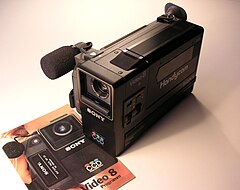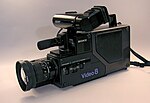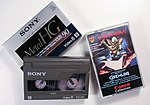Video 8
| Video 8 | |
|---|---|

|
|

|
|
| Bandwidth: | 8 mm |
| Colour: | Subcarrier |
| Volume: | Helical track / PCM |
| Running time: | 0.5-4 hours |
| Introduction: | 1985 |
Video 8 was developed in 1985 by some Japanese and American companies (especially Sony and Polaroid ) to replace the 1/2-inch video cassettes such as VHS or Betamax in the portable sector that were previously used .
The magnetic tape is 8 mm wide and the cassette is about the size of a Philips music cassette . The small size of the cassettes enabled Sony to build compact amateur video cameras similar to other companies with VHS-C . The tapes initially ran for 60 minutes at normal speed (SP), later longer tapes were also offered. The successor to Video 8 was Hi8 from 1989 and Digital8 from 1999 .
Procedure
This format was specially designed to be as small and light as possible. One of the first cameras Sony launched in 1985 was the CCD-M8E . This still had an optical viewfinder and easily fit in one hand. Sony touted it as the smallest camcorder in the world. To view the recording, however, you needed a separate playback device.
Parallel to the “smallest camcorder in the world”, Sony also offered the CCD-V8AF model with autofocus, built-in black and white video viewer and playback option . Due to its dimensions and weight of around 2.3 kilograms, including battery and cassette, this was less manageable.
In contrast to most of the video formats of that time, Video 8 does not need any synchronous or audio heads. The former were replaced by a technology that was also used in Video 2000 . The consistent use of FM sound made it possible to dispense with separate tape heads . In addition, some recorders also had the option of digitally recording sound ( PCM ). As with VHS , the color signal is recorded at a lower frequency than the brightness signal ("color under"). The sound was recorded in HiFi quality and was superior to the sound of the VHS format.
application
Initially it was also planned to bring movies in Video-8 format onto the market. At the end of the 1980s there were a few providers, but the format could not prevail against the long-established VHS system for cinema films.
Video 8 was particularly popular with camcorders . There were also home video recorders in this format. However, in contrast to the portable devices, these could not achieve a significant market share.
From 1986 to 1990 there were some multi-PCM devices such as B. the EVS-850PS. An audio-only mode could be activated here, which then divided the cassette into 6 tracks to be recorded in parallel and thus enabled hi-fi recordings with up to 6 × 240 minutes (24 hours) of music in PCM quality (15 kHz).




